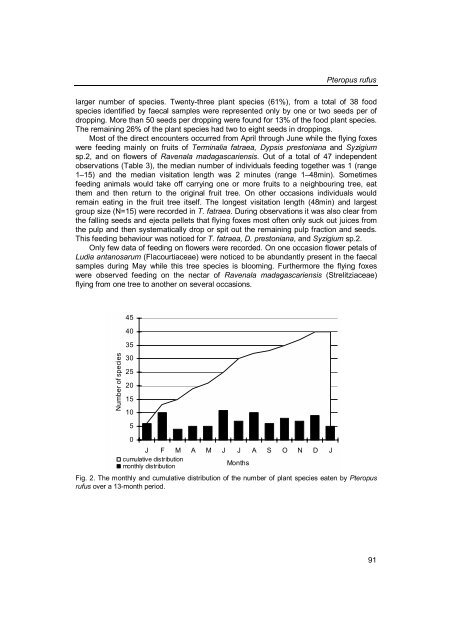Fruit-frugivore interactions in a Malagasy littoral forest - Universiteit ...
Fruit-frugivore interactions in a Malagasy littoral forest - Universiteit ...
Fruit-frugivore interactions in a Malagasy littoral forest - Universiteit ...
Create successful ePaper yourself
Turn your PDF publications into a flip-book with our unique Google optimized e-Paper software.
Pteropus rufus<br />
larger number of species. Twenty-three plant species (61%), from a total of 38 food<br />
species identified by faecal samples were represented only by one or two seeds per of<br />
dropp<strong>in</strong>g. More than 50 seeds per dropp<strong>in</strong>g were found for 13% of the food plant species.<br />
The rema<strong>in</strong><strong>in</strong>g 26% of the plant species had two to eight seeds <strong>in</strong> dropp<strong>in</strong>gs.<br />
Most of the direct encounters occurred from April through June while the fly<strong>in</strong>g foxes<br />
were feed<strong>in</strong>g ma<strong>in</strong>ly on fruits of Term<strong>in</strong>alia fatraea, Dypsis prestoniana and Syzigium<br />
sp.2, and on flowers of Ravenala madagascariensis. Out of a total of 47 <strong>in</strong>dependent<br />
observations (Table 3), the median number of <strong>in</strong>dividuals feed<strong>in</strong>g together was 1 (range<br />
1–15) and the median visitation length was 2 m<strong>in</strong>utes (range 1–48m<strong>in</strong>). Sometimes<br />
feed<strong>in</strong>g animals would take off carry<strong>in</strong>g one or more fruits to a neighbour<strong>in</strong>g tree, eat<br />
them and then return to the orig<strong>in</strong>al fruit tree. On other occasions <strong>in</strong>dividuals would<br />
rema<strong>in</strong> eat<strong>in</strong>g <strong>in</strong> the fruit tree itself. The longest visitation length (48m<strong>in</strong>) and largest<br />
group size (N=15) were recorded <strong>in</strong> T. fatraea. Dur<strong>in</strong>g observations it was also clear from<br />
the fall<strong>in</strong>g seeds and ejecta pellets that fly<strong>in</strong>g foxes most often only suck out juices from<br />
the pulp and then systematically drop or spit out the rema<strong>in</strong><strong>in</strong>g pulp fraction and seeds.<br />
This feed<strong>in</strong>g behaviour was noticed for T. fatraea, D. prestoniana, and Syzigium sp.2.<br />
Only few data of feed<strong>in</strong>g on flowers were recorded. On one occasion flower petals of<br />
Ludia antanosarum (Flacourtiaceae) were noticed to be abundantly present <strong>in</strong> the faecal<br />
samples dur<strong>in</strong>g May while this tree species is bloom<strong>in</strong>g. Furthermore the fly<strong>in</strong>g foxes<br />
were observed feed<strong>in</strong>g on the nectar of Ravenala madagascariensis (Strelitziaceae)<br />
fly<strong>in</strong>g from one tree to another on several occasions.<br />
Number of species<br />
45<br />
40<br />
35<br />
30<br />
25<br />
20<br />
15<br />
10<br />
5<br />
0<br />
J F M A M J J A S O N D J<br />
cumulative distribution<br />
monthly distribution<br />
Months<br />
Fig. 2. The monthly and cumulative distribution of the number of plant species eaten by Pteropus<br />
rufus over a 13-month period.<br />
91

















